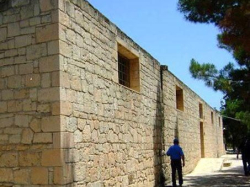Archaeological Museum of Aegina

Archaeological Museum of Aegina
The Museum of Aegina was founded by Governor Ioannis Kapodistrias in October 1829 in Aegina, the then capital of the newly formed Greek State (after the revolution of 1821 against the Turks). It was the fulfillment of Kapodistrias' vision to gather all the ancient findings of Greece in one place. Initially, the museum was accommodated in the Kapodistrian Orphanage, while from 1929 to 1980 it was housed in the Einardio building next to the Diocese of the city of Aegina. The first director of the museum was Andreas Moustoxydis. From 1981 until today, it is found in a building located in the area of Kolona that is a donation of the Bavarian Association of Friends of the Museum of Aegina. Access to the venue is easy as it is only a few minute's walk from the port of Aegina.
The architecture of the building is based as a ground floor scheme, built of stone, with a tiled roof, equal sides, and has a patio in the center. It consists of 3 rooms that contain various exhibits such as finds from the Temple of Aphaia, the statue of Hercules, several other marble statues, jewelry, bronze utensils, coins, and inscriptions. The Sphinx of Aegina holds a special place among the exhibits. This is a statue from 460 B.C. is dedicated to the god Apollo - with the head of a woman and the body of half an eagle and half a lion.
Impressive is the representation of a 2-story house of the Early Helladic period called "White House", as well as multiple objects / tools of everyday life at that time. Do not forget to note that in the area of the patio, there are the tomb reliefs of the cemetery of Rineia (the cemetery is located on the island of Delos) that visitors can admire.
Also, it is worth mentioning that the collection of the museum is intended in the future to be transferred to the place where it originated, the Kapodistrian Orphanage - which is being set up to house the "Timeless Museum" of Aegina.








